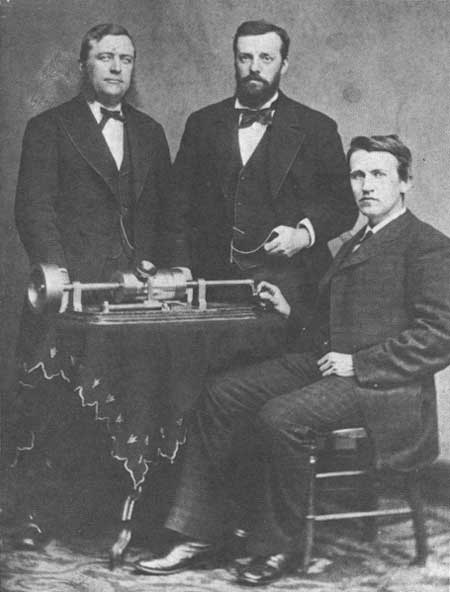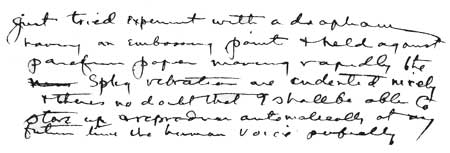|
Beehives of Invention Edison and His Laboratories |
 |
Crucibles of Creativity: The Labs(continued)
For the next few years Edison was almost completely immersed in electric power distribution and use. He invented an enormous variety of the gadget and power-handling necessities for a commercial lighting system. Even with the help of the "new breed" of assistants like Upton, most of the system was born out of Edison's empirical methods.
Soon most Americans believed Edison's statement that "after this we will make electric light so cheap that only the rich will be able to burn candles." He had gained their confidence a few years before, in 1877, when he displayed the most original of all his inventions, the phonograph.
After The Lamp, He Created A Whole Electric System More Information |
This amazing device was born out of the striving by Edison to improve the inefficient telephone transmitter patented by Bell and out of some thought-provoking experiments with an embossing device for use in recording telegraphic messages. He attached a needle to one of the vibrating diaphragms used in his telephone experiments. He ran waxed paper under the device while shouting into the diaphragm. The shouting caused the point of the needle to make tiny impressions on the paper according to the quality and power of Edison's voice. When he ran it back under the needle at the same speed with which he ran it through originally, he got something which he and Charles Batchelor thought bore some remote resemblance to the human voice.
John Kruesi made a machine the way Edison had sketched it—a hand-cranked cylinder mounted to turn freely with a diaphragm and stylus so mounted that the tinfoil-covered cylinder would "walk" under the diaphragm. Into the machine Edison recited "Mary had a little lamb" while a disbelieving staff snickered. When he turned the machine back to the starting point and began to crank again, the smirks turned to stunned disbelief because there, squawking but clear, was the Old Man's voice. It was the first time in history that human speech had been recorded.
 Edison demonstrates his tinfoil phonograph at Washington in April 1878, nine months after making his first known notation about the possibilities of such a machine at the bottom of a sketch of the improved telephone transmitter: "Just tried experiment with a diapham having an embossing point & held against parafin paper moving rapidly the Spkg vibrations are indented nicely & theres no doubt that I shall be able to store up & reproduce automatically at any future time the human voice perfectly." Behind the phonograph are, left, Uriah Painter, his host in Washington, and Charles Batchelor. |
|
For a long time some people thought there was trickery. One morning at Menlo Park a gentleman came to the laboratory and asked to see the phonograph, It was Bishop Vincent . . . I exhibited it, and then he asked if he could speak a few words. I put on a fresh foil and told him to go ahead. He commenced to recite Biblical names with immense rapidity. On reproducing it he said: "I am satisfied, now. There isn't a man in the United States who could recite those names with the same rapidity." Thomas A. Edison, as quoted in Edison: His Life and Inventions, 1910 |
"I was never so taken aback in my life," Edison said later. "Everybody was astonished. I was always afraid of things that worked the first time."
He demonstrated the phonograph before members of Congress and President Rutherford B. Hayes in Washington. Thousands of people journeyed to Menlo Park to hear recorded sound. Edison considered the phonograph mainly a functional device, not a medium of entertainment. But at first he did not even pursue its functional possibilities, such as using it as a dictating machine. He put it aside for 10 years and turned his energies to electric power.
After inventing the incandescent lamp, he opened a factory to manufacture bulbs, he developed intricate equipment to generate and to distribute electric current, and he established an electrical lighting system in New York City.


|

|
|
|
|
Last Modified: Thurs., May 19 2005 10:00:00 am PDT |


